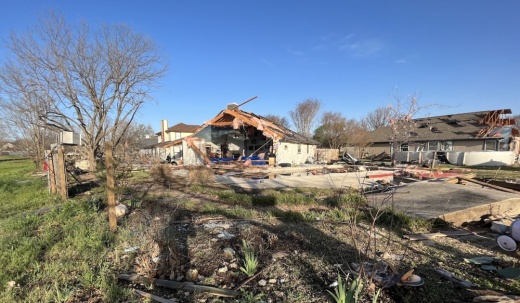“I've lived in Austin for 11 years and this is the first tornado I've ever seen,” said Jennifer Olohan, public information and marketing program manager for Austin’s Community Preparedness Programs. “They are uncommon. But it should be a wakeup call for everybody for any kind of emergency.”
Troy Kimmel, chief meteorologist for KOKE FM and senior lecturer at The University of Texas, said he believes tornado season for Austin is year round.
“There is a peak in the spring, I would say in March, April, May," he said. "But, that doesn't mean that is the only time we're going to see [tornadoes]. ... They can happen any time of the year.”
The Austin Homeland Security and Emergency Management office has a risk index that ranks the “potential impact of natural and man-made hazards that threaten the city of Austin.” Tornadoes are ranked fifth out of the 14 disasters on the list.
The city of Austin does not have a siren system for extreme weather events such as tornadoes. The only siren in the city is located on the UT campus and is used to alert students of extreme weather and other safety concerns. The university instructs students to seek shelter in the nearest building when they hear the siren or move into the interior rooms or hallways away from windows until they get the “all clear” notification.
Kimmel said the March 21 storm was the first time UT has activated its siren system that was installed in 2007 due to weather. He does not think a siren system is necessary for the city because in other towns and counties sirens can be counterproductive.
“I think in a way we have some better tools that are more technologically advanced than the siren, and to some degree, we have found that the siren system oftentimes causes more confusion," he said.
Both Kimmel and Olohan suggest residents sign up for weather notifications on their mobile devices and take tornado watch and warning alerts seriously.
Kevin Sheth, the president of the climate and meteorology society at UT, described the difference between a tornado watch and warning: A tornado watch is when all the ingredients are present for a tornado to form, and a tornado warning means there have been tornados spotted and you need to get inside immediately.
“Have multiple layers of information through the news and social media so that you're getting constant updates on information and the storm,” Olohan said.
Registering for emergency warnings online can help residents get live updates in addition to watching news broadcasts and keeping up with social media. Olohan and Kimmel said Austinites can sign up on www.warncentraltexas.org, a free emergency system that connects local officials to communities to maintain contact during disasters and public safety events.
The most important part of tornado safety, Kimmel stressed, is being prepared before another one happens.
“You’ve just got to have a plan. I can't stress this enough. Wishing and hoping is not a plan,” Kimmel said.
A tornado preparedness plan should include a meetup spot in case household members are separated, batteries, nonperishable foods and flashlights, Olohan said.
When inside a house, Kimmel recommends separating oneself from the tornado with walls.
“Go to the lowest floor of the building you're in; if you're in a substantial shelter, foundation house, go to the lowest floor and put as many walls between you and the tornado as you can,” Kimmel said.
If a tornado strikes when someone is driving, Olohan advises getting inside a building as soon as possible.
“You have to get inside. Being in a car is not good. Get off the road. If that's pulling off into a gas station or library, do it,” Olohan said.
Kimmel also recommended protecting your head, either with your hands or another protective instrument.
“Get a bicycle helmet, put it on. In the southeast, I can tell you we've had people survive and found kids with their football helmets on,” Kimmel said.
Making a plan before the threat of a storm is the best solution to ensure your family stays safe, Olohan said.
“If you're trying to make those plans once we get that tornado warning it's too late,” Olohan said. “I hope that for everyone this is the point we say we were kind of unprepared. Let's make sure our family has a plan.”
What to do if a tornado hits your area
The National Weather Service and Texas Severe Storms Association offer tips based on where residents may be located in the event of a tornado touching down nearby.
- In a home: If you are in a tornado warning, go to a basement, a safe room or an interior room away from windows. Grab pets if time allows.
- In a vehicle: Everyone inside should abandon the vehicle immediately because vehicles and mobile homes offer no protection from tornado winds. If residents are in either of those locations, they should leave and seek safety in a substantial structure or designated tornado shelter. Residents should not attempt to seek shelter beneath an overpass or bridge, which have proven to be deadly options.
- In a high-rise or apartment building: Residents should seek shelter in the smallest or most interior rooms or hallways and avoid exterior walls and windows.
- Outside: Residents should seek shelter inside a sturdy building immediately if a tornado is approaching. Sheds, storage facilities, mobile homes and tents are not safe.





